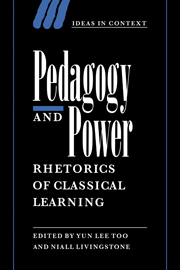Book contents
- Frontmatter
- Contents
- Notes on contributors
- Acknowledgements
- Introduction
- 1 Classics: from discipline in crisis to (multi-)cultural capital
- 2 Schoolboys and gentlemen: classical pedagogy and authority in the English public school
- 3 ‘Die Zung’ ist dieses Schwert': classical tongues and gendered curricula in German schooling to 1908
- 4 ‘What does that argue for us?’: the politics of teaching and political education in late eighteenth-century dialogues
- 5 Women and classical education in the early modern period
- 6 Pilgrimage to Parnassus: local intellectual traditions, humanist education and the cultural geography of sixteenth-century England
- 7 ‘Not so much praise as precept’: Erasmus, panegyric, and the Renaissance art of teaching princes
- 8 Teachers, pupils and imperial power in eleventh-century Byzantium
- 9 Reading power in Roman Greece: the paideia of Dio Chrysostom
- 10 Children, animals, slaves and grammar
- 11 A good man skilled in politics: Quintilian's political theory
- 12 The voice of Isocrates and the dissemination of cultural power
- 13 Xenophon's Cyropaedia: disfiguring the pedagogical state
- Select bibliography
- Index
- IDEAS IN CONTEXT
10 - Children, animals, slaves and grammar
Published online by Cambridge University Press: 30 September 2009
- Frontmatter
- Contents
- Notes on contributors
- Acknowledgements
- Introduction
- 1 Classics: from discipline in crisis to (multi-)cultural capital
- 2 Schoolboys and gentlemen: classical pedagogy and authority in the English public school
- 3 ‘Die Zung’ ist dieses Schwert': classical tongues and gendered curricula in German schooling to 1908
- 4 ‘What does that argue for us?’: the politics of teaching and political education in late eighteenth-century dialogues
- 5 Women and classical education in the early modern period
- 6 Pilgrimage to Parnassus: local intellectual traditions, humanist education and the cultural geography of sixteenth-century England
- 7 ‘Not so much praise as precept’: Erasmus, panegyric, and the Renaissance art of teaching princes
- 8 Teachers, pupils and imperial power in eleventh-century Byzantium
- 9 Reading power in Roman Greece: the paideia of Dio Chrysostom
- 10 Children, animals, slaves and grammar
- 11 A good man skilled in politics: Quintilian's political theory
- 12 The voice of Isocrates and the dissemination of cultural power
- 13 Xenophon's Cyropaedia: disfiguring the pedagogical state
- Select bibliography
- Index
- IDEAS IN CONTEXT
Summary
In the classical west the possession of language made an early appearance in lists of what were claimed as human prerogatives, and swiftly became a fixture there, taking its place alongside such varied items as reason; upright posture and gait; a face or countenance; a sense of humour; sciences and skills; the ability to plan for the future; the capacity to form general concepts or beliefs; and morality. The uniqueness of our status as language users was often and powerfully challenged: but at least some of the evidence in its favour must, one feels, have been as obvious and as persuasive as it is today. Then, as now, human infants (literally ‘non-speakers’) typically came to understand at least one language, in contrast, it appears, to all other animals, including even the chimpanzees reared by diligent 20th-century researchers. (The Roman god Uaticanus, who presided over the beginnings of human speech, took the initial syllable of his name from the first sound children utter: Aulus Gellius noct. att.xvi xvii 2.) Almost effortlessly, in a predictable sequence, with only informal and haphazard instruction and correction from speakers lacking special didactic skills and having at best only generalised didactic motivation, human offspring move from a radically languageless state to mastery of their native tongue, phonology, morphology, syntax, idioms, intonations, and all.
But that is how a linguist today might describe the situation.
- Type
- Chapter
- Information
- Pedagogy and PowerRhetorics of Classical Learning, pp. 214 - 244Publisher: Cambridge University PressPrint publication year: 1998
- 9
- Cited by

